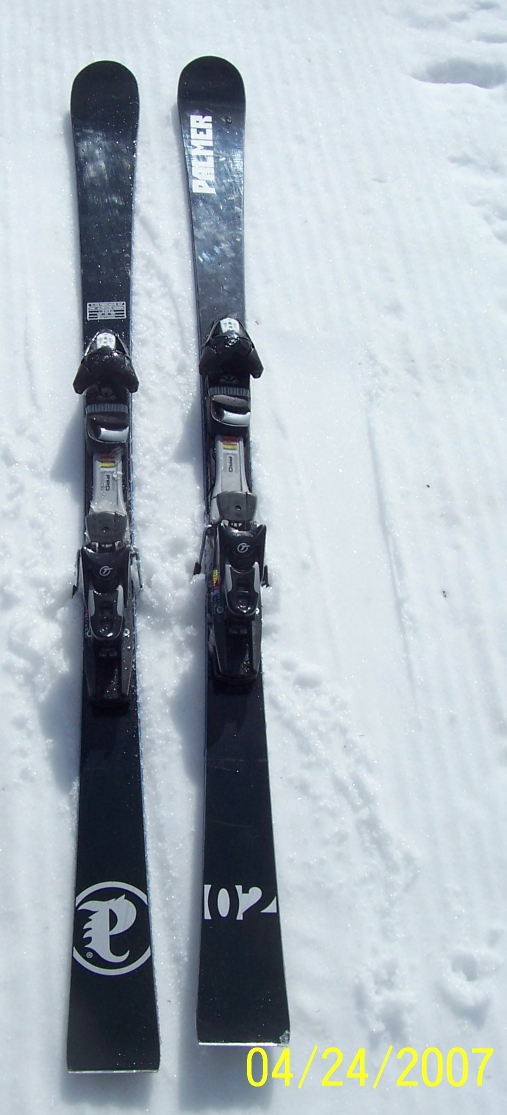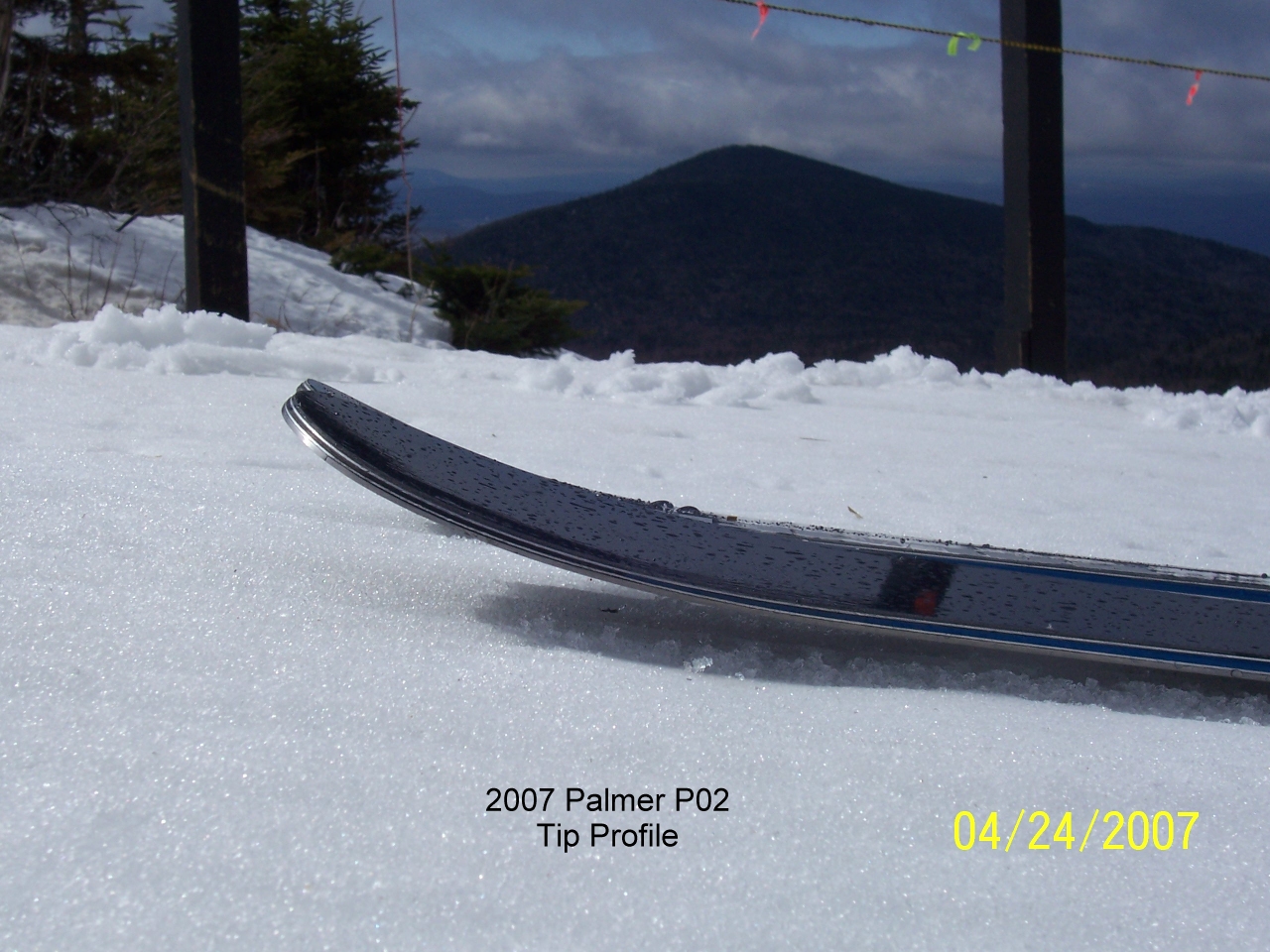Palmer P02 163cm 120-68-107
12.5m radius @ 163cm
2007-2008



Note: Palmer catalog declares ALL lengths (155cm, 163cm and 172cm) have the same 12.5m radius.
Each length has a different geometry - very interesting:
155cm = 114-66-101
163cm = 120-68-107
172cm = 128-70-115
MSRP:
P02 with Tyrolia / Palmer Binding: $1200 usd, w/o binding:$ 900 usd
Manufacturer Info:
Palmer Snowboards Ltd.
1037B Broadway
Denver, CO. 80202
(303) 623-0334
USA http://www.palmerusa.com
Manufactured in Austria
(From the looks of the sidewall text...maybe in the Head factory?)
Usage Class:
All mountain carving & performance.
Palmer states "Easy to ride, with Titanium for grip and agility, and the performance of DPD Klothoid."
Your Rating (with comments): (1="get me off these things"->10="I have to own a pair")
9
Summary:
Excellent carving ski for non-muscleheads. Finely tuned machine with a very freindly behavior. Remarkably effortless and very, very interesting. The description in their catalog is accurate: "P02 hits a home-run with all expert skiers looking for ultimate agility and speed in any terrain..."
Ski Designer (if known):
Rumored to have some design elements by Hansjürg Kessler (multi-time snowboard worldcup winner and design guru).
Technical Ski Data (if known):
NCF Prepeg beech/poplar wood core sandwich construction with titanium.
DPD* Klothoid geometry** with laminated cyan sidewalls.
7200 graphite base
Tyrolia carve plate 13 SLR (13mm height)
Pre-Skiing Impression:
Good quality construction and finish. Sparse, clean, simple name graphic on blank, glossy topsheet.
First impression was "wow, look how THIN they are." (not width, but vertical thickness)
The P02's vertical profile is indeed very thin, with 5mm thickness at the tip (unladended resting contact point), 12.5mm at the boot center mark and 5mm at the tail.
My trusty Nordica 16.1 racecarves are typical of many "carving skis" with vertical thickness of 8mm tip and tail, 17.5mm at the boot center mark.
The Palmer P02s are indeed very thin skis. My reaction was "don't bend them - stay out of the serious bumps". Eyeballing the sidecut revealed they have a prounounced, almost "extreme" carving geometry.
Not quite an "extreme carver" or "hyper carver" in a 163cm. ("extreme carvers" are very popular in Europe - imagine doing your best "Apolo Anton" short-track speedskating impersonation, but on snow...no poles, dragging your hip on the snow...maybe laying out front on your chest like a snowboard carver... see the extreme carving gallery at for excellent example photos)
My second impression was "wow, look how flat the shovel is."
(see the DPD description below)
Background: - What is "DPD" and "Klothoid geometry" ?
*DPD = "Dynamic Power Distribution"
According to Palmer, DPD is the design of the tip and tail in such as manner as to dynamically allot the power distributed to the edge throughout a turn to prevent "digging" and "skidding". This spreads the resistance created when the snow deformation increasingly apposes the motion of the turn of the ski on edge. It reportedly reduces resistance, making the turn smoother and grippier as it reduces effort to maintain the carve. The design of the DPD is apparently targeted at extending the numerous radii of the "Klothoid" sidecut into the tip and tail regions, optimizing edge contact and pressure gradients along that contact surface. The user is supposed to experience reduced nose edge pressure and greater control. If you compress the skis against the snow surface, the contact point is farther down the ski's length than with "traditional" designs. Essentially, the nose and tail are flatter than traditional designs.
** "Klothoid" geometry
According to Palmer, the Klothoid (also spelled "clothoid" in many reference books and articles) geometry produces an extremely high-performance sidecut with dynamic pressure properties. The general description of the Klothoid or Clothoid spiral curves is:
"The clothoid or double spiral is a curve, whose curvature grows with the distance from the origin. The radius of curvature is opposite proportional to its arc measured from the origin."
These curves are typically utilized in railroad track corner designs or roller coaster loop-de-loops which attempt to minimize the amount of input force required to complete the curve or loop, while minimizing the centripital force experienced by the passenger. Essentially, you utilize an ovoid-type of curve instead of circular as the path proceeds from entry to exit of the apex. Maybe it works for skis?
Palmer has invested a great deal of effort in promoting its sidecut geometry and mating new shovel and tail profiles to that geometry to produce what it calls "A revolution in shape technology." The marketing hype from the sales materials works very well prior to trying the skis. "A" for marketing effort. (but I'm a notorious skeptic about all the poly-raz-ma-taz manufacturers spill out in ads and promo materials...having seen plenty of design "revolutions" come and go).
Test Conditions:
Late spring snow. Groomed corn and pocky, rotted surfaces from very warm days. Not refrozen for at least 48 hours. Corn had unlimited depth, edges of trails in the shade had firmer, softening ice base where you could find semi-hard surfaces. Soft, easy-going bumps with very low-profile faces. Superb spring conditions.
Test Results:
First thing I noticed while cruising down the cat-track to some favorite runs was when I rolled the skis over from left to right...watching them spray corn as they rolled along the virgin groomer courduroy (yeah, yeah, I should watch where I'm going...not look down at the skis while tooling along...I know, I know..) the corn snow was spraying NOT from the widest part of the shovel, but back from the shovel about 6-8 inches... Very odd. Something you'd expect if you bent the b'jeepers out of your skis in the bumps and kept skiing them.. The Palmer "DPD" apparently does splay the tip back as the ski is decambered...moving the contact point away from the tip, down toward the center of the ski as it is pressured. Very interesting. These skis were 163cm, shorter than I usually ski, but they were very stable at speed, damp and never nervous, especially with their fairly deep sidecut and short radius of 12.5m @163.
Second thing I noticed was they do not appreciate being muscled. The Palmer P02 is a finely tuned carving tool, NOT a "bear down and force it to stay" race carver. There is a difference between an all-mountain high-performance carver and a race carver, and the Palmer P02 is not a race-derived ski (although you could probably do pretty well with them in your favorite beer league). I got the distinct impression I was supposed to cut fine arcs with these, not dig trenches. Once I backed off the brute force, these skis suddenly responded with very refined feedback and a eagerness to carve parallel railroad tracks in both directions with very little effort. Just roll your ankles or do a little lateral move, and bingo - carving left - carving right. No twitch, no muss, no fuss, any speed you want. Change direction at any time - early in the turn, in the middle of the turn, or late in the turn - no problem. I immediately realized I wanted a squeeky-dry, cold, man-made surface or very dense packed-powder surface to run these skis on. Spring mush is not their element, but they worked effortlessly anyway.
Third thing I noticed was they do not have explosive power, just quick, quiet carving efficiency. Not boring, just deceptively civilized (until you look back at what kind of turns you just put down). The more runs I took the more I realized this was a surgical instrument for pretty much any speed and terrain without deep snow. This ski could bring an advanced intermediate skier instantly into an semi-expert level carving experience with very little coaching. It can bring a perfectly skilled expert skier into some new carving territory with very little effort. It may well be one of the best women's carving skis I can think of, due to its impressive finesse and remarkably light weight. One expert woman we met absolutely loved these skis. The thin profile of this ski allows it to be extremely light. In an age where boat-anchor skis like the Atomic Metron series are popular carving tools in short lengths, the Palmer P02 is a refreshingly light ski which also lays down equally serious arcs....without the bulk, weight and effort of many competitors in this category.
This leads to a final observation. The Palmer P02 is remarkably effortless. It didn't sink in until after I finished up the testing session. Because of its low weight, corresponding low swing-weight (a sadly retired term), and perhaps its geometry and flex pattern, the P02 can allow the skier to arc serious cuts into the surface of dozens of different runs all day without encountering the fatigue often associated with other frontside carving skis. That's significant. Overall, I really like what this ski has to offer.
I totally agree with SierraJim's review of this ski. Not immediately extraordinary, but impressive the more you live with it.
Analogies: (this ski is like...)
Finely honed ninja carving tool - finely crafted, not to be abused.
After Skiing These, I Want To...
Try the 172cm size, then decide which one to buy and go find some man-made hardpack to slice.
Self-Description of Skiing Style, Ability, Experience, Preferences (be honest):
Expert groomed-surface carver, "old-style" race inspired, "foot steerer" with fairly sensitive edging feel. Loves to hold long arcs with lots of pressure on the downhill ski (you know the type), but also loves the feel of both skis on-edge leaving tiny railroad track edge tracks. Not an instructor, but 10 year coach for youth race team in New England (bulletproof is the norm).
SierraJim's review over at the excellent BarkingBear forums of Epicski.com:
http://forums.epicski.com/showthread.php?t=50787